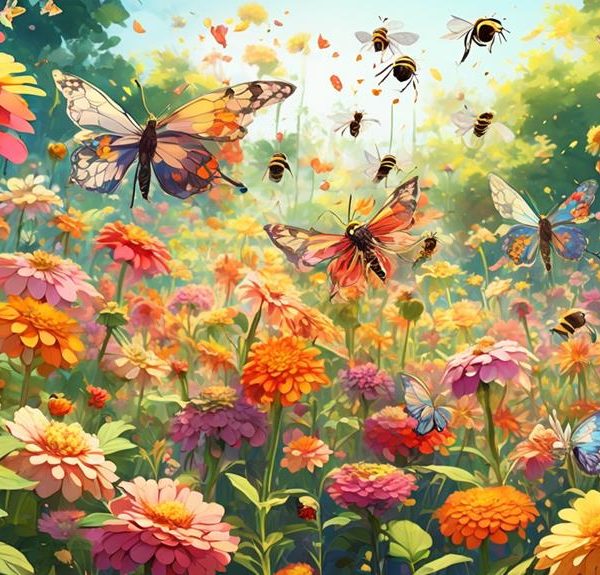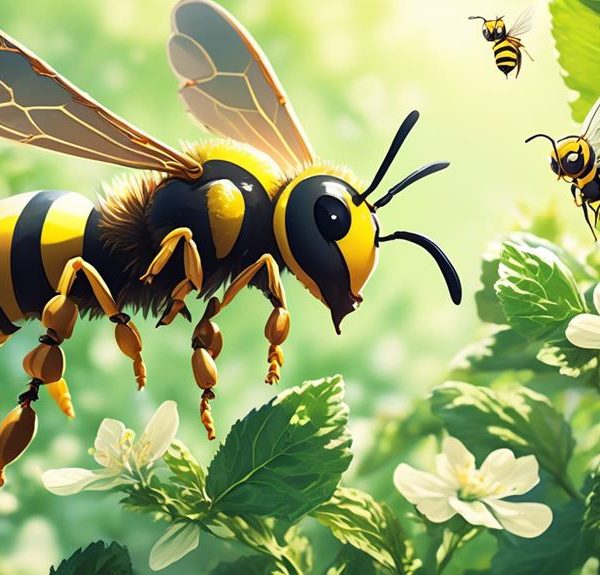Traverse the intriguing world of bees and wasps, as we uncover their affinity for lavender's captivating allure.
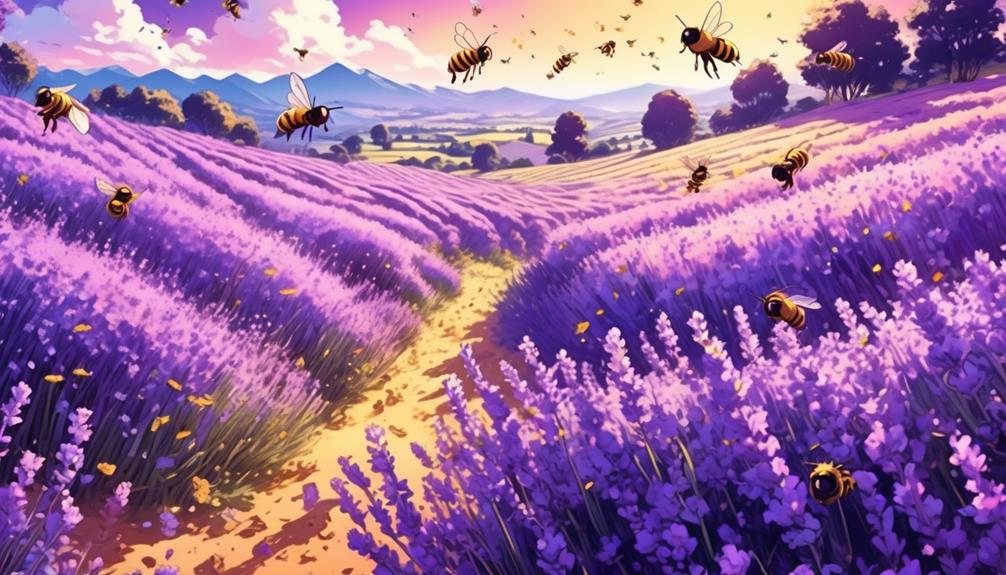
Do Bees and Wasps Like Lavender?
In the tranquil world of your garden, the gentle hum of bees and the busy buzz of wasps create an unusual symphony. You might wonder if these insects, with their diverse roles in our ecosystem, are attracted to the same floral scents that you are. Specifically, you're curious about lavender, known for its calming aroma and striking purple hues.
As an avid gardener or just a nature enthusiast, you've probably noticed these insects hovering around these plants frequently. But is it the lavender they're drawn to, or is there something else at play?
With a fascinating combination of science and observation, let's explore this intriguing interaction further.
Key Takeaways
- Bees and wasps are attracted to lavender due to its strong, sweet fragrance and vibrant purple color.
- Lavender serves as a rich source of nectar for bees, supporting their food source and aiding in pollination.
- Wasps are also attracted to lavender for its fragrance and color, but they do not contribute to pollination like bees.
- Planting lavender in your garden can attract beneficial insects, but it's important to maintain a diverse range of flowering plants for a balanced ecosystem.
Understanding Bees and Wasps Attraction
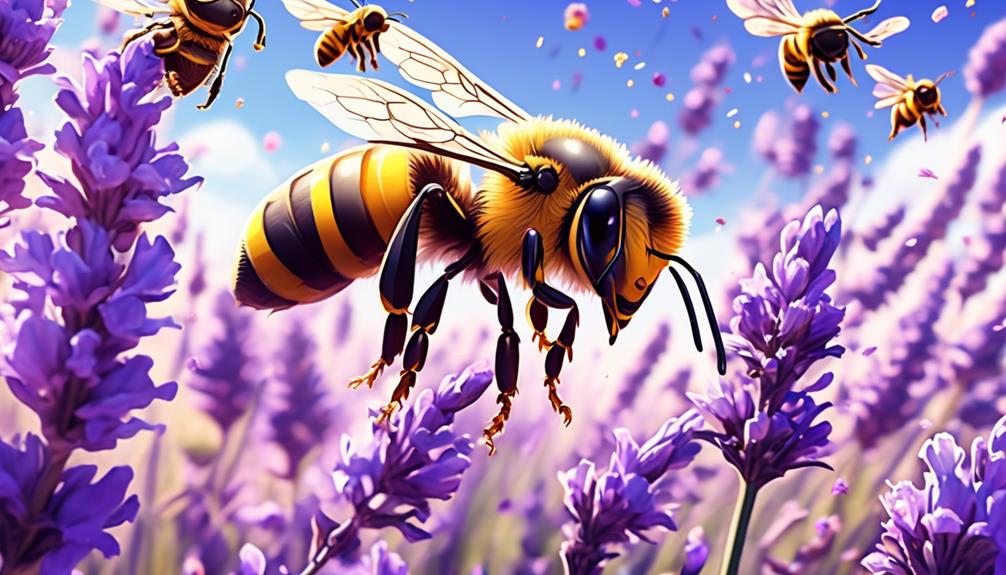
To understand why bees and wasps are attracted to lavender, you need to delve into their biology and the plant's specific characteristics. Bees and wasps, like many insects, have a keen sense of smell. Their antennae, covered with olfactory receptors, are specifically designed to detect floral scents. They're particularly drawn to strong, sweet fragrances, and lavender fits the bill perfectly.
But it's not just about the scent. Lavender's physical characteristics also play a role. The plant's small, tubular flowers are ideally suited to the feeding habits of bees and wasps. Their narrow, elongated bodies can easily access the nectar at the base of the flower, and in return, they help in the pollination process.
Moreover, lavender blooms throughout the summer, the same period when bees and wasps are most active. This constant availability of nectar makes lavender a reliable food source for these insects.
Lastly, the color of lavender flowers, a vibrant purple, is highly attractive to bees and wasps. These insects see in the ultraviolet spectrum and are especially drawn to blue and purple hues. It's a perfect match, really.
Lavender: The Irresistible Fragrance
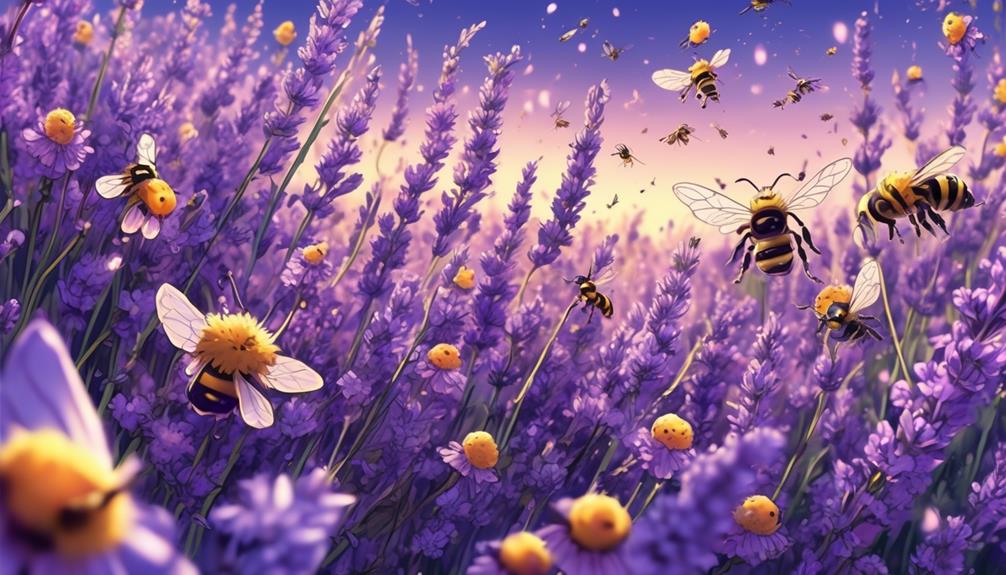
Diving into the irresistible allure of lavender, you'll find that its potent aroma, stemming from a complex blend of over 100 individual compounds, plays a significant role in its attractiveness to bees and wasps. This olfactory delight is a beacon, guiding these creatures to its rich nectar reserves.
Compound | Role in Attraction |
|---|---|
Linalool | Main aromatic compound |
Limonene | Adds citrus undertone |
Caryophyllene | Brings woody note |
Myrcene | Imparts earthy aroma |
Camphor | Introduces cooling sensation |
Each compound contributes to the enchanting scent profile of lavender, causing a sensory experience that bees and wasps find irresistible. The linalool, with its floral, sweet scent, is the most prevalent compound, making up 30-40% of the total. Limonene and caryophyllene add citrus and woody undertones, respectively, while myrcene lends an earthy aroma. Camphor then introduces a cooling sensation.
Intriguingly, it's not just the individual scents, but the unique combination that makes lavender so appealing to these insects. You see, bees and wasps possess an advanced sense of smell, allowing them to discern this complex combination of fragrances. This combination, as it turns out, is the key to unlocking the mystery of lavender's irresistible allure.
Exploring the Bee-Lavender Relationship
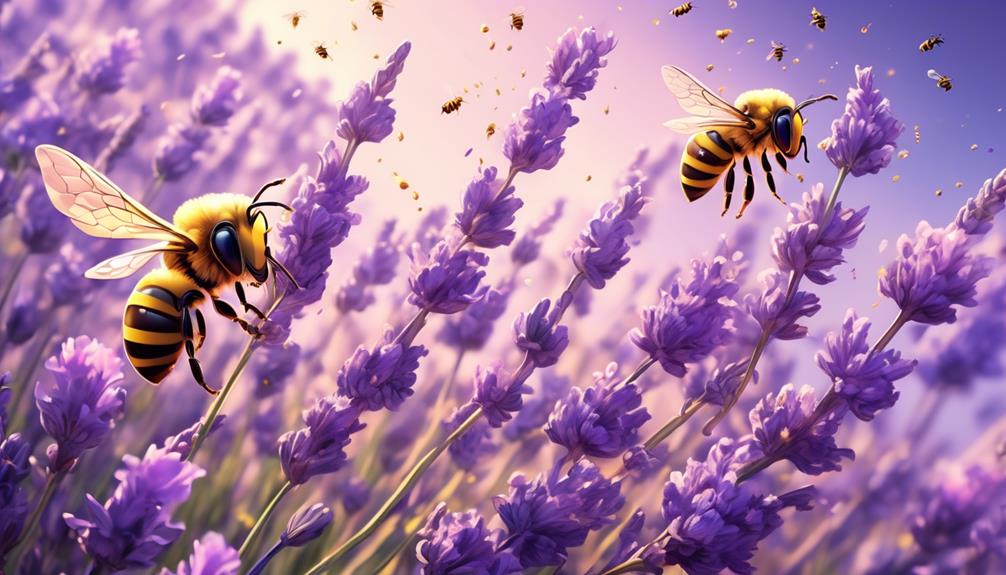
Building on the complex allure of lavender's scent, we can now explore how this intricate blend of fragrances influences the relationship between bees and the lavender plant itself. The nectar-rich lavender flowers are a veritable feast for bees. They're attracted to the strong, sweet aroma, using their highly evolved sense of smell to navigate to these purple havens.
Analyzing the bee-lavender relationship, it's not just the scent that's significant, but the color too. Bees have a unique visual spectrum, capable of seeing ultraviolet light. Lavender's vibrant purple coloration, easily visible to bees, is like a beacon calling them to the flowers.
Additionally, lavender's lengthy blooming period provides a consistent nectar source for bees, contributing to the symbiotic nature of their relationship. In return, bees assist in the pollination of lavender, which is essential for the propagation of the plant species.
However, it's not a one-sided affair. Lavender benefits from the bees' visits too. As bees flit from flower to flower, they inadvertently carry pollen on their bodies, facilitating cross-pollination and ensuring the continuation of diverse lavender populations. It's a win-win interaction, reinforcing the critical role bees play in maintaining biodiversity.
Wasps' Interaction With Lavender
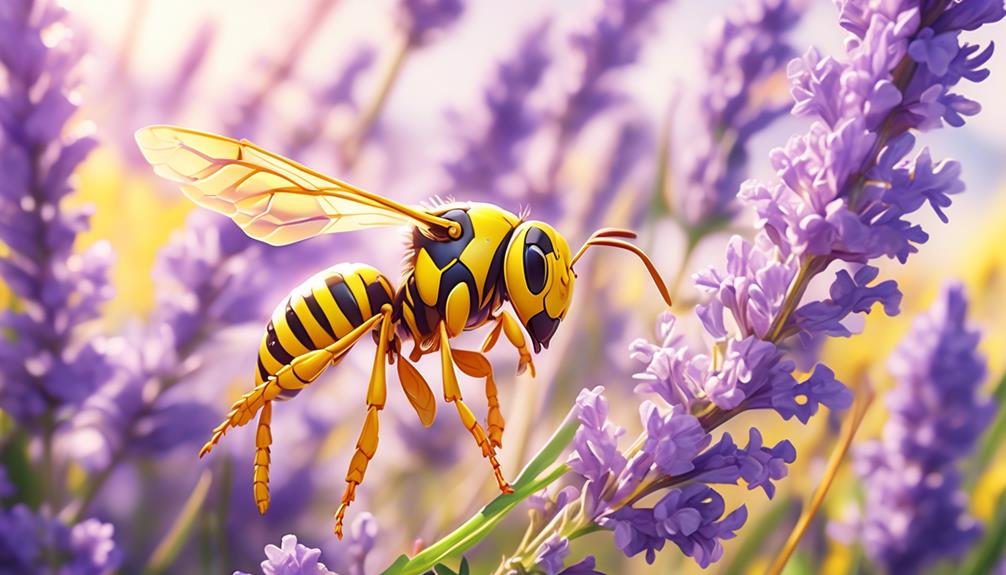
Just like bees, wasps too, are enticed by lavender's potent fragrance and vivid hues, but their interaction with the plant is a bit more complicated. Wasps, unlike bees, are not primary pollinators. They lack the body hair that bees use to collect and distribute pollen. So, while they're attracted to lavender's aroma and color, they don't benefit the plant in the same way bees do.
To understand this difference better, let's break it down:
Property | Bee | Wasp |
|---|---|---|
Body Hair | Present | Absent |
Primary Role | Pollinator | Predator |
Interaction with Lavender | Collect/Distribute Pollen | Attracted but not Helpful |
Benefit to Lavender | High | Low |
Reason for Attraction | Nectar and Pollen | Sweet Nectar |
These details illustrate why, despite their similar attraction to lavender, wasps and bees have distinct roles in the ecosystem. You'll notice wasps hovering around lavender plants, drawn by the sweet nectar, but they're just guests enjoying the buffet. They don't contribute to lavender's pollination like their bee counterparts.
Impact on Gardening and Ecosystem

Understanding the varied interactions between bees, wasps, and lavender can greatly impact your gardening practices and the overall health of your local ecosystem.
When you choose to plant lavender, you're not only enhancing your garden's aesthetics and fragrance, but also attracting beneficial insects that aid in pollination.
Bees and wasps, which are drawn to lavender's nectar, are key pollinators. Without them, your garden's productivity could decline. Additionally, these insects help maintain biodiversity within your local ecosystem. They're integral to the lifecycle of many plant species, aiding in their reproduction.
However, it's not all rosy. Some wasps, such as yellow jackets, can be aggressive and are potentially hazardous if they establish nests near human activity. Proper management is therefore essential.
Furthermore, overreliance on lavender as a primary source of nectar can lead to an unbalanced ecosystem. Bees and wasps need a variety of plant species for a balanced diet. Therefore, it's smart to incorporate a diverse range of flowering plants in your garden.
Frequently Asked Questions
How Can I Safely Remove Bees or Wasps Attracted to My Lavender Plants?
To safely remove bees or wasps drawn to your lavender plants, you'll need to create a distraction. Place a sugary solution a few feet away from the plants. They'll be attracted to this sweet treat.
Then, carefully trim the lavenders, reducing their appeal. Always wear protective clothing to avoid stings.
If the problem persists, consider hiring a professional pest control service. Remember, bees are essential pollinators, so try not to harm them.
What Other Plants Can I Grow to Attract or Deter Bees and Wasps?
You're considering other plants to attract or deter bees and wasps, right?
To attract them, plant bee balm, sage, or sunflowers. They love these!
To deter them, try marigold, geraniums, or pennyroyal. These plants aren't appealing to them.
Can the Presence of Bees and Wasps Affect the Quality or Growth of Lavender?
Yes, the presence of bees and wasps can indeed affect the growth and quality of your lavender plants.
Bees help in pollinating, leading to healthier and more abundant blooms.
Wasps, though not as efficient pollinators as bees, help by controlling pests that may harm your lavender.
However, a high concentration of these insects might stress the plants.
It's all about balance; you don't want an infestation, but a few can be beneficial.
Are There Specific Types of Lavender That Are More Attractive to Bees or Wasps?
You're wondering if certain types of lavender are more enticing to bees or wasps. Absolutely! Both these insects are particularly drawn to English and French lavenders. Their vibrant blooms and strong scent act like a magnet.
However, the English variety, with its high nectar production, is the clear favorite. So, if you're planning a garden and want to attract these pollinators, these are your go-to species.
How Does the Climate or Season Affect the Attraction of Bees and Wasps to Lavender?
Season and climate significantly affect your bees and wasps' attraction to lavender. In warmer climates and seasons, they're more active and attracted to lavender because it's blooming.
However, in colder climates or seasons, you'll notice less activity as these insects hibernate.
Conclusion
So, you've now understood bees and wasps' fondness for lavender. The irresistible scent draws them in, creating a mutual relationship between the insect and the plant.
While bees gather nectar and assist in pollination, wasps, though not as efficient pollinators, still contribute. This relationship not only enhances your garden's beauty but also supports a healthy ecosystem.
So, don't hesitate to plant some lavender and enjoy the added buzz of activity in your yard.

